#john roebling
Explore tagged Tumblr posts
Photo



Replacing the International Railway Bridge, 1896-7, Niagara Falls New York.
John Roeblings famous rail suspension bridge, had become too small for the increasing size of train engines and length of trains by the 1890s. Yet it was too important to take out of service while being replaced, so engineer Leffert L Buck, who had been hired to build the new span, built the new bridge around the old. one, a feat made possible by the the new bridge was an arch design, and would not interfere with the towers and cable of Mr Roeblings bridge.
When the new bridge was completed, the old bridge was dismantled, the last bits removed by August 27, 1897. The New Bridge took the uninspiring name of The Lower Steel Arch Bridge until 1937 when it was renamed the Whirlpool Rapids Bridge.
#Niagara falls#bridges#railroads#1897#1890's#the new one not the old one#john roebling#leffert l buck
196 notes
·
View notes
Text
The Curious Histories of 17 Lost Bridges of Cincinnati
Over the years, Cincinnati’s waterways were crossed by many long-gone bridges. Some still generate fond memories. Others were a relief to demolish.
First Millcreek Bridge The first bridge across the Millcreek, a sort of pontoon affair located about where the Sixth Street viaduct now runs, was only two years old when it was demolished by a flood in 1808. It took three years to cobble together the funds for a replacement, an elevated structure opened in 1811. The 1822 flood erased that span. A third bridge was washed away by the 1832 flood and floated down to Louisville, where it was disassembled, towed back to town and rebuilt, only to be later destroyed by fire.
Original Deer Creek Bridge Around 1800, the only bridge across Deer Creek was short, but necessary. The gorge spanned by the bridge was only about 12 feet wide, but quite deep. To protect this bridge from the fate of its Western counterpart on the Millcreek, the bridge tenders piled loads of stone along the approaches for thirty feet or more each way from the banks. These rocky anchors managed to hold the bridge in place until it was replaced by a more substantial structure.
The First Ohio River Bridge In September 1862, Cincinnati was in full-blown panic. Confederate troops edged ever northward through Kentucky, obviously aimed at an invasion of Union territory at Cincinnati. General Lew Wallace (later to earn fame and fortune as the author of “Ben Hur”) was in command of the defense of the Queen City. Wallace had abundant troops, but no way to get them across the Ohio River to Kentucky. Roebling’s suspension bridge was nothing but unfinished pylons. It was at this moment that Wesley M. Cameron offered to construct a bridge across the Ohio. His pontoon bridge, completed in just 30 hours, was built from coal barges maneuvered into a row across the Ohio with planks laid across them. The bridge ran just east of today’s Suspension Bridge and was wide enough for two Army wagons to pass side-by-side.
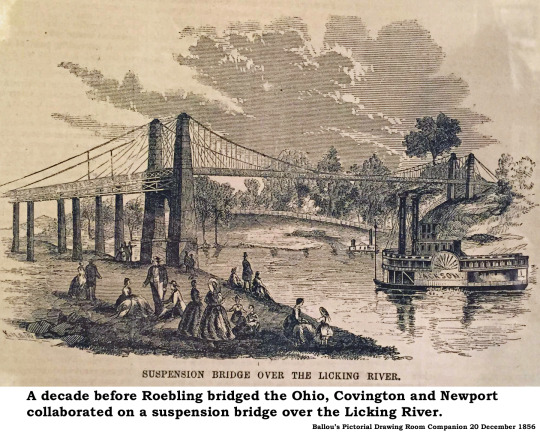
Original Suspension Bridge Cincinnati is justly proud of our iconic Suspension Bridge, but that was not the first suspension bridge in this area. A suspension bridge linking Covington and Newport over the Licking River opened in 1853, more than a decade before the completion of John Roebling’s masterpiece. On 16 January 1854, that predecessor tumbled into the Licking River, along with 18 head of cattle, two drovers and a couple of commuters on horseback. None of the humans were seriously injured, nor were most of the livestock, but the disaster caused some reconsideration of plans for the Ohio River bridge. The Licking bridge was rebuilt and later reinforced under the supervision of Washington Roebling, John’s son. It was was replaced in the 1880s and again in the 1930s.
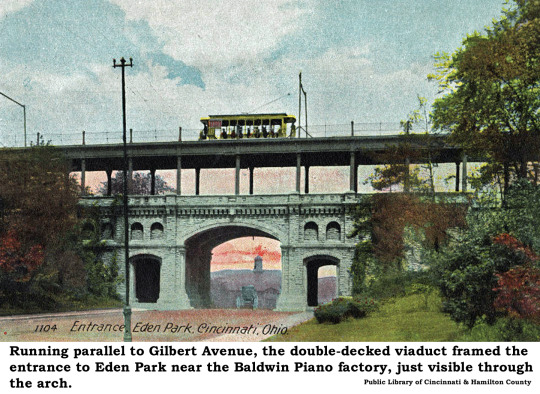
Eden Park Bridge A double-deck stone bridge once crossed the main drive of the Gilbert Avenue entrance to Eden Park. The top deck carried the tracks of the Zoo-Eden Streetcars. The lower, seldom used, deck provided an excellent vantage point for pedestrians to view the reservoirs and the Greek Revival rear portions of the Art Museum. The bridge was built in 1874 and demolished in 1949, with piles of fieldstone offered for sale at bargain rates.
Grandin Road Viaduct Delta Avenue runs downhill in the bed of a stream, now imprisoned by concrete pipes, once known as Crawfish Creek. Over the years, that creek gouged a pretty deep valley between Hyde Park and Columbia-Tusculum. In 1905, the valley was bridged, but as early as 1960, the span was seriously showing its age and was finally demolished in 1975, leaving two orphaned segments of Grandin Road. This lost bridge was also known as the Delta Avenue Viaduct.
Elm Street Bridge(s) A feature of special occasions in Cincinnati was the construction of elaborate but temporary bridges over Elm Street to connect Music Hall (and its predecessor Exposition Buildings) with Washington Park. Apparently first constructed for the United States centennial in 1876, an elaborately ornate covered bridge marked the 1888 centennial of the founding of Cincinnati. Other Elm Street bridges were constructed as late as 1910.
The Little White Bridge Today, the location of the famous Little White Bridge is buried under interstate highway traffic. At one time, it was a scenic landmark along the upper reaches of the Miami-Erie Canal, connecting the eastern end of 69th Street in Carthage to the grounds of the Longview Hospital. Originally constructed of wood in 1860, it was replaced by a metal structure in 1874, still painted white. The color and the destination spawned an idiom: To say that someone “crossed the white bridge” implied they had gone insane. The Little White Bridge was demolished in 1955 as I-75 plowed through the area.
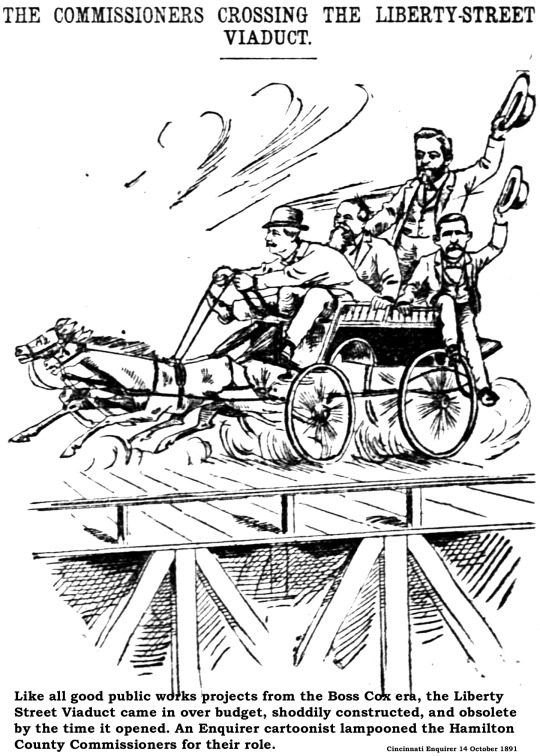
Liberty Street Viaduct The very definition of boondoggle was exemplified by the Liberty Street Viaduct over the Millcreek. Debated for decades, Hamilton County commissioners finally commenced construction in 1888, but the span wasn’t completed until 1891. At that time, it was the longest bridge ever erected in the county and cost the – at that time – astronomical expense of $135,000. So poorly constructed that the city refused to certify it, the viaduct was barely wide enough for horse-drawn wagons and pedestrians. The shoddy monstrosity lingered in increasingly decrepit condition until 1929, when it was put out of its misery in preparation for construction of the Western Hills Viaduct.
Spring Grove Covered Bridge Motorists today drive Spring Grove Avenue over the Millcreek into Northside on an utterly unremarkable span in the shadow of I-74. Up until 1900, however, that route passed through a wooden covered bridge. Although sentimentally scenic, the darkness offered by the timbered superstructure provided excellent hiding places for footpads and highwaymen. According to the newspapers, no traveler would pass over the Spring Grove bridge unless heavily armed, and there was general rejoicing when it was razed.
Harrison Avenue Viaduct The new Harrison Avenue viaduct wasn’t even finished on 6 August 1908 when someone tried to blow it up. The attempted sabotage was sloppy work. Damage to the steel pillars was minimal and the shattered concrete plinth was easily replaced. The contractor for the job was a non-union shop and the foreman told police he thought a union agitator had planted the bomb. He was correct. The International Association of Bridge and Iron Workers, struggling to find a toehold in the construction industry, decided on drastic measures. Between 1905 and 1911, the union detonated nearly 100 explosions in 17 states from Massachusetts to California.
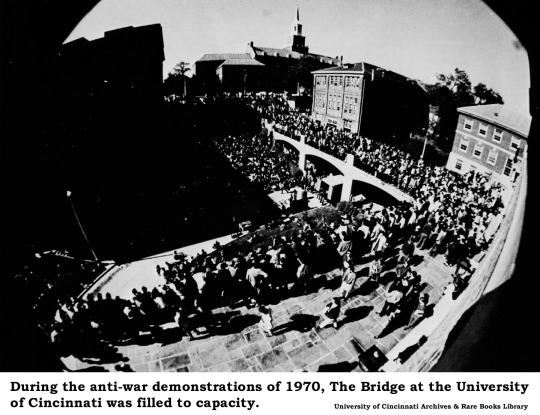
Tangeman Center Bridge For those University of Cincinnati alumni of a certain age, the memory of “The Bridge” brings a fond tear to the eye. First constructed as part of the 1960s expansion of the Tangeman University Center, the Bridge – formally the Veterans Memorial Bridge – supported parties, demonstrations, speeches, picnics, concerts and courtships until it was demolished in 2001 to make way for a pedestrian plaza. A short little span now connects the Tangeman Center to UC’s College-Conservatory of Music. It bears the old Veterans Memorial Bridge plaque, but it just isn’t the same.
An Electric Bridge The Findlay Street bridge over the Miami & Erie Canal was accidentally electrified in 1904 when an overhead trolley wire came undone and draped across the iron railing of the bridge. A drove of hogs refused to cross the sparking structure, squealing as they lifted one foot at a time and trying to shake off the tingling current. Horses unleashed showers of sparks from their horseshoes as they pranced over the bridge, leaping about like frisky colts until a passing electrician finally shut off the current. Like all the other canal bridges, this bridge was demolished during the construction of Central Parkway.
Bridgetown Trestle Can we still call it Bridgetown if there is no bridge? Although this Green Township community took its name from Bridgeton, New Jersey, hometown of some early settlers, Bridgetown was identified for decades with a Chesapeake & Ohio railroad trestle that straddled the intersection of Glenway, Race and Bridgetown roads. The last train rolled over the trestle in 1981, but the structure lingered, blocking traffic signals and hosting hordes of pigeons for several years until it was finally razed in 1984.
Central Bridge The Central Bridge, also known as the Cincinnati-Newport Bridge, was constructed in 1890. It ran from the foot of Ludlow Street on the Cincinnati side to York Street on the Newport side. Built to handle horse-and-buggy traffic, the span was woefully outclassed by automobiles and its wooden deck regularly caught fire because of discarded cigarettes. A good-sized crowd braved frigid temperatures to watch the demolition of this landmark on several days in March 1992. It was replaced by the functional yet uninspiring Taylor-Southgate Bridge.
Queen City Avenue Bridge Over the years, the Millcreek has been spanned by a menagerie of mostly decrepit bridges that, despite their utter disregard for safety, became essential routes into the Western Hills. The Queen City Avenue Bridge was one such atrocity. By the early 1900s, it was so deteriorated that only one automobile or street car could cross it at any one time. When a new Harrison Avenue Viaduct was built in 1908, the city wanted to demolish its Queen City Avenue neighbor, but the Lunkenheimer Valve Company objected, claiming the bridge was essential for transporting products.
The Authentic Lost Bridge Ironically, the only local bridge actually called “The Lost Bridge” is not lost. It’s right there as Lawrenceburg Road crosses the Great Miami River south of Elizabethtown. True, this is the fourth bridge erected at that crossing and, true, one of its predecessors burned and another was washed away in a flood, but the bridge itself has been pretty much there the whole time. What has been lost is a universally accepted rationale for calling it the lost bridge.
11 notes
·
View notes
Photo







John A. Roebling – Scientist of the Day
John Augustus Roebling, a German/American civil engineer, died July 22, 1869, at the age of 63.
read more...
#John Augustus Roebling#civil engineering#bridges#canals#histsci#histSTM#19th century#history of science#Ashworth#Scientist of the Day
33 notes
·
View notes
Photo

Rain Man (Barry Levinson, 1988) John A. Roebling Suspension Bridge / Roebling Suspension Bridge Cincinnati, Ohio - Covington, Kentucky (USA) Bridge over the Ohio river Type: suspension bridge.
#rain man#barry levinson#1988#john a. roebling suspension bridge#roebling suspension bridge#cincinnati#ohio#covington#Kentucky#USA#ohio river#suspension bridge#bridge#tom cruise#dustin hoffman#valeria golino
20 notes
·
View notes
Photo








The John A. Roebling Suspension Bridge was formally opened on January 1, 1867.
#John A. Roebling Suspension Bridge#Cincinnati-Covington Bridge#opened#USA#1 January 1867#anniversary#US history#Ohio River#Cincinnati#Covington#Kentucky#Ohio#architecture#cityscape#engineering#travel#John A. Roebling#John Augustus Roebling#tourist attraction#landmark#original photography#summer 2016#Midwestern USA
3 notes
·
View notes
Photo

Suspension Bridge, Cincinnati, Ohio.
43 notes
·
View notes
Text
Emily Warren Roebling
Getting back into the swing of blogging. Here's a post about one of my favourite historical figures: Emily Warren Roebling on the anniversary of her birth
Emily Warren Roebling was born on 23 September 1843 in Cold Spring, New York as the second-youngest of the twelve children of Sylvanus and Phebe Warren. Roebling had always had an interest in pursuing education, something that was supported by her older brother Gouverneur “G.K.”, with whom she was close. She attended the Georgetown Visitation Academy in Washington, D.C., which still exists under…

View On WordPress
#American History#Brooklyn#Brooklyn Bridge#Building the Brooklyn Bridge#Emily Warren Roebling#History#John A Roebling#Washington Roebling
2 notes
·
View notes
Photo

Roebling Bridge in December, Cincinnati, OH
#John A Roebling#Suspension Bridge#Cool bridge#cincinnati ohio#ohio#dusk#lights#reflection#nighttime photography#winter#winter photography#architecture#city scape#cityscape#kentucky#ohio river#smale park#puddle#puddle reflection#water reflection#light photography#city lights#bridge#iphone photography#iphonex
31 notes
·
View notes
Text
I've said once and I'll say it again, Cincinnati is literally so beautiful. I mean, look at this bridge !!

it was the prototype for the Golden Gate Bridge!
5 notes
·
View notes
Photo
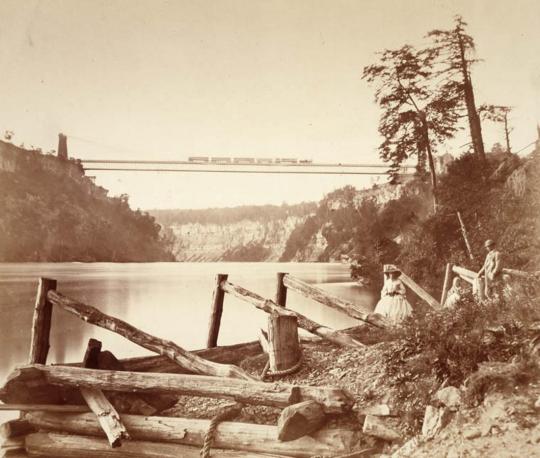

Picnicing by the Niagara Railroad Bridge, Niagara Falls, New York.
Built by engineer John Roebling of Brooklyn Bridge Fame in 1855, The International Suspension Bridge, Its official name, brought rail traffic across the Niagara River and the border of the United States and Canada until 1897. The bridge was considered an engineering marvel and attracted tourists who also came to view the Falls, which can be seen in the distance in the second photo.
It had finally become too small for the amount of traffic from the New York Central, the New York and Erie Railroad and Canada’s Great Western Railway, and was replaced by an arch bridge.
126 notes
·
View notes
Photo



Black bean burger with fried onions on top, deep fried pickle chips, and a view.
1 note
·
View note
Video
At The Door by William Fultz II
2 notes
·
View notes
Text
John A. Roebling Once Said...
John A. Roebling Once Said…

John Augustus Roebling was born Johann August Röbling on June 12, 1806, and died on July 22, 1869. John was a German-born American civil engineer and it was his ingenuity that helped him build wire rope suspension bridges.
The John A. Roebling Bridge which spans Cincinnati, Ohio to Covington, Kentucky over the Ohio River was completed in 1867 and was at the time the world’s longest suspension…
View On WordPress
0 notes
Text
Il 24 Maggio 1883, apre il Brooklyn Bridge
Il 24 Maggio 1883, apre il Brooklyn Bridge
Brooklyn Bridge
Il ponte di Brooklyn. Disegnato da John Augustus Roebling il 24 Maggio 1883 per la prima volta fu attraversato dalle persone e ha rappresentato per lungo tempo il ponte sospeso più grande al mondo.
La costruzione del ponte iniziò nel 1869.

© ANTONINO BARTUCCIO 2019 – Tutti i diritti Riservati – All Rights Reserved
Interested in running this feature in your…
View On WordPress
#24 Maggio 1883#Bridge - Man Made Structure#Brooklyn#Brooklyn - New York#Brooklyn Bridge#Built Structure#CHITECTURE#City#Cityscape#Downtown District#Dusk#EAST RIVER#Famous Place#John Augustus Roebling#Manhattan#Manhattan - New York City#New York#New York City#NEW YORK STATE#Night#River#Skyscraper#Street#Sunset#Suspension Bridge#Taxi#Traffic#Tramonto#Transportation#Urban Scene
0 notes
Photo
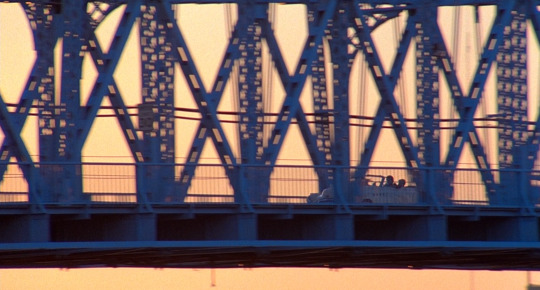
Rain Man (Barry Levinson, 1988) John A. Roebling Suspension Bridge / Roebling Suspension Bridge Cincinnati, Ohio - Covington, Kentucky (USA) Bridge over the Ohio river Type: suspension bridge.
#rain man#barry levinson#1988#john a. roebling suspension bridge#roebling suspension bridge#cincinnati#ohio#covington#Kentucky#USA#ohio river#suspension bridge#bridge
3 notes
·
View notes
